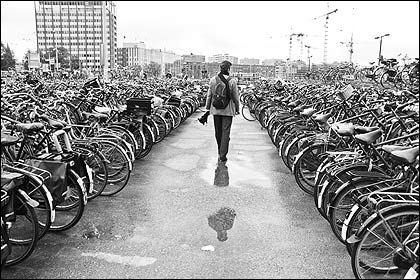
Amsterdamized
UO course imports cycletrack success
 |
| Photo by Marc Schlossberg |
About 50 people packed the Humble Beagle Pub last week to get a glimpse at how Eugene could become like Amsterdam, where more people bike to work than drive.
Students from a course on “Sustainable Bicycle Transportation” visited the Dutch city last summer and brought back pictures, video and ideas on making a greener Eugene that they shared with the local community on Nov. 3.
“It was fantastic,” said UO graduate Briana Orr of the eight-day trip to Amsterdam with a dozen other students. Orr, UO’s Bike Center Project Coordinator, said she’d read about Amsterdam’s 38 percent bike commute rate but, “I don’t think you really get the understanding unless you’re biking in it.”
Orr attributed the city’s cycling success to its system of safe cycletracks physically separated from motorists. “It’s definitely the infrastructure. It’s facilities that make women, make children, feel comfortable,” she said. “This was the first time biking that I didn’t feel like I was going to get hit by a car.”
UO planning professor Marc Schlossberg said he was a “skeptic” about the importance of separated cycletracks before he went. But he said, “I returned convinced about how amazing it is.”
Eugene’s bike system largely consists of bike lanes. But while that may work for the bravest 5 percent of potential cyclists, if your goal is actually to increase that to get a good majority of people,” Schlossberg said, “a bike lane doesn’t cut it.”
In Holland the separated cycletracks protected from cars by curbs provide bikers convenient, safe, pleasant and direct routes, “all the things we give to cars,” Schlossberg said. The cycletracks provide space “where regular people can bike to do their regular things and not have to worry and be tense. They can relax,” he said.
Ted Sweeney, a student in the Department of Planning, Public Policy and Management, said he saw lots of regular people on bikes in Amsterdam. “There were kids, moms with their toddlers, older people, professionals in suits, well-dressed women, plus everything in between,” he said. “All kinds of people were biking because it was really easy and convenient to do.”
With policy and infrastructure changes, it was “eye-opening to imagine what may be possible for American cities,” Sweeney said.
“It was hard to imagine why every city that is serious about bicycles doesn’t build similar infrastructure,” said Sophie Luthin, another UO student on the trip.
Eugene has taken a first step toward the Dutch model of cycletracks. This summer the city installed a two-way bikeway on Alder for about a dozen blocks near the UO. For most of the route, the bikeway is protected by a wide painted strip instead of a curb or other physical barrier and isn’t like the physically separated cycletracks in Holland. But for two blocks, the route is behind a lane of parked cars and safely protected from cars.
Luthin said she was “thrilled” to see the Alder improvement when she returned to school after visiting Amsterdam. “It’s awesome, and I can’t wait for more,” she said.
More could be on the way. The city’s draft new bike and pedestrian plan includes a major cycletrack on High Street connecting the Amazon bike path to downtown and the riverfront path system.
A citizen advisory committee of the powerful Metropolitan Planning Committee (MPC) has also recommended that the region’s transportation plan include a policy that “it is preferable that bicycles and pedestrians be physically separated from the flow of traffic.”
After objections from Springfield and MPC staff and right-wing County Commissioner Jay Bozievich, the MPC staff watered down the recommendation to read: “it is preferable, when practical, that bicycles and pedestrians be as physically separated as possible from the flow of motorized traffic.”
The Amsterdam cycling photos will stay up at Humble Beagle through Nov. 17. Schlossberg said about 85 students have expressed interest in another course next summer that will also include Copenhagen.
If physically separated cycletracks can get imported here, that could provide a big boost to proposed city plans to double cycling rates. Orr said when she got back from visiting Amsterdam and rode Eugene’s streets next to cars, “I was a bit shaken up.”
A longer version of this story first appeared at EugeneCycles.com
|
|
|||||||
|
|
|||||||
|
Table of Contents | News | Views | Blogs | Calendar | Film | Music | Culture | Classifieds | Personals |
|||||||